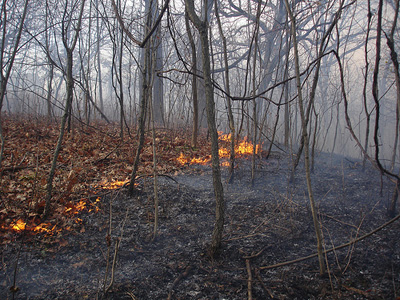What being green means to most of America
My parents have let the lot at the home in Galena, IL return to natural Illinois prairie. This is cool in a natural-historical way, and certainly beautiful*, but it also takes a bit of work to rehabilitate the land after the tumult of excavation and construction. So, they hired the company Prairie Works as landscape consultants who’ve guided the process of planting and, in the case of the photo below, burning of the grasses as happens naturally every so often.

Recently I came across the Prairie Works blog maintained by Cory Ritterbusch and have been surprised at how interesting it is. City boy adds blog about prairie grass to his reader, imagine that. Consider the post about the culture of lawns in America:
In 2006 the American lawn reached a higher status among its citizens – it became the country’s largest irrigated crop. Between our golf courses, sports fields, town squares and residential lawns turfgrass now covers an amazing 40 million acres, or 80 percent, of non-farmed land.
40 million acres, sweet jesu. That’s a lot of agriculture for show.
Although the 1/2-acre area of grass that is carefully manicured by its owner seams rather harmless, it is the large-scale ramifications of millions of such owners that prove to be devastating. In 2005 it took 238 gallons of water per person to irrigate 40 million acres of turfgrass, which are being mowed with 800 million gallons of small engine gasoline and kept green by 70 million pounds of chemicals. All this costs an estimated 30 billion dollars annually (2005). The effects on water and air quality are staggering as are the 68,000 injuries sustained annually while mowing.
Am I the only one staggered by the amount of gasoline and water that it takes to keep something up that is in most cases an extension of a home’s aesthetic rather than functional?
Oddly enough, lawn care advertising confirms that most residential lawn care is a losing battle against climate, pests, traffic and other variables, unless more efforts, including watering and chemicals, are applied to the cause. The 70 million pounds of chemicals applied to turfgrass annually represent a higher concentration of chemical input than any other form of agriculture worldwide.
My suburban friends have probably stopped reading by now and written this post off as the rantings of a guy with a postage stamp-size parcel of grass in the city. Against lawns? That’s un-American! But I have to believe that there’s a sizable majority of middle America who, in suddenly eco-conscious America, believes that their ginormous lawns are part of the solution to environmental problems. I’m not sure that’s entirely true, but happy to read otherwise in the comments.
* Even if it does have an abandoned lead mine on the property. Ecologically sound or not?













